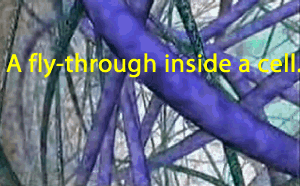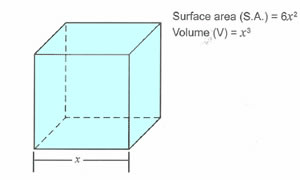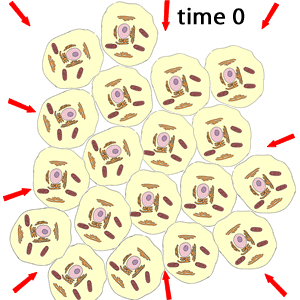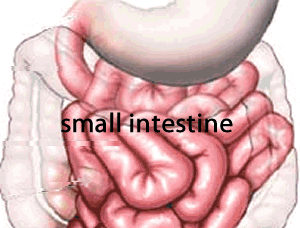
Although cells are the fundamental building blocks of multicellular organisms they themselves are extremely complex. The internal environment of a cell can be thought of as a chemical soup where interactions between chemicals are well organised and timed to perfection. The animation above shows how busy the interior of a cell is. Click to see a more detailed explanation of the internal environment of a cell and its organelles.
Living cells require a quick supply of nutrients and need to remove waste rapidly before damage is done to the cell. For this reason, cells can not afford to grow too big. The bigger the cell the slower the rate at which nutrients move into all parts of the cell and waste moves out.
A critical factor known as the surface area to volume ratio determines the rate of diffusion of solutes in and out of the cell. The ratio also determines the rate of heat loss from the organism to the environment. The higher the ratio the greater the rate of diffusion of nutrients into the cell and waste out of the cell. For large multicellular organisms, heat loss to the environment increases as the surface area to volume ratio increases.

What is the surface area to volume ratio of a cube with a length of 6 cm?
What is the surface area to volume ratio of a cube with a length of 0.6 cm?

This slow process of particle movement, known as diffusion, becomes a real problem for multicellular organisms that consist of many cells bundled together to form tissues. The inner most cells of such huge cell aggregates become starved of nutrients and overcome by the toxicity of their own waste products.
This is why blood vessels are crucial for the supply of nutrients to all cells and removal of waste away from all cells.

1) Explain how the following words are related. organ, organism, tissue, cell, system.
5) A paramecium and a euglena are examples of unicellular organisms.
i) What is meant by the terms unicellular and multicellular?
ii) The euglena is an organism that lives in pond water. It would be better if this organism was bigger. It could photosynthesise more as it could carry more chloroplasts and it could store more food. Why has the euglena not evolved to be a larger organism than it is?
6 The small intestine can be considered an organ dedicated to absorption of nutrients and the movement of food along its length. It is made up of specialised tissues that contain similar cells. The animation on the right zooms in on some of the features of the small intestine.
i) Muscle tissue is prevalent. Explain why.
ii) Blood vessels are also abundant. Why?
iii) Notice the unique shape of the epithelial cells that line the inside of the small intestine. What is their function and what is the feature that allows them to fulfill that function.
